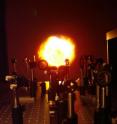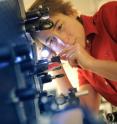Illuminating the no-man's land of waters' surface
Water repelling molecules are said to be hydrophobic. The hydration -- or formation of water interfaces around hydrophobic molecules -- is important for many biological processes: protein folding, membrane formation, transport of proteins across an interface, the transmission of action potentials across membranes. It is involved as well in the process of creating mayonnaise, or in the fact that you can get rid of fat with soap. Hydrophobic interfaces although long studied, are poorly understood. Here's an amusing kitchen-table experiment to illustrate waters unusual properties: put a drop of pure insulating oil in a glass of pure, non-conducting water, and create an electric field using two wires hooked up to a battery. You'll see the oil move from the negative to the positive pole of the little circuit you've created. You have created charge in a mixture that was neutral, and a huge amount of it too, judging from the speed at which the droplets move. The same thing happens for gas bubbles in water; the phenomenon of charging applies to all hydrophobic/water interfaces.
A century of debates
It's not a new discovery; scientists have observed the phenomenon in the middle of the 19th century. But despite more than a century of research, the reason why such a huge electric charge exists is still the subject of heated debate.
In an article published this week in Angewandte Chemie -- a journal of reference in the field -- EPFL scientist Sylvie Roke challenges a hypothesis put forward last spring in the same journal. With experimental proof to back her up, the holder of the Julia Jacobi chair in photomedicine makes her case: the phenomenon is not caused by the inevitable "impurities" present in oils, as her colleagues claim, but rather by certain intrinsic properties of the water molecules involved.
Show the unseeable
For proof, Roke turns to the technologies in which she is an expert -- nonlinear optics and light diffusion. Using carefully filtered lasers channeled through a complex circuit of mirrors and lenses, she "hits" her sample -- barely a drop -- and measures the wavelength of the light that escapes from it. With this she can detect whether or not there are nanoscopic molecules on the interface between the oil and the water.
The precision of the observations "shows that negative charges exist even in a total absence of surface impurities, and thus the explanation put forward by my colleagues, which was derived from charge measurements and chemical titrations of the bulk liquids, doesn't hold up," says Roke. "We have developed a unique apparatus that can distinctly measure the interfacial structure of a layer on the sub-nanometer length scale that surrounds a droplet of oil in water. Thus, we can 'see' what is on the interface, and do not have to deduce it from comparing bulk properties, which is far less accurate."
Disproving a hypothesis isn't enough to explain a phenomenon, however. Roke is studying a promising avenue, that explores the intrinsic quantum nature of the water molecule itself, which might be responsible for the phenomenon. "The measurements we've made as part of this refutation could be used to try and prove this explanation," she says. "It's fascinating, because quantum effects (the smallest of the smallest) might be responsible for macroscopic charging effects that influence so many properties that relate to the functioning of the human body."
Source: Ecole Polytechnique Fédérale de Lausanne
Other sources
- Illuminating the no-man's land of waters' surfacefrom PhysorgTue, 27 Nov 2012, 17:31:25 UTC

